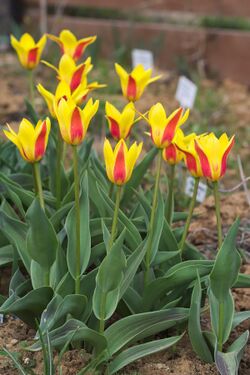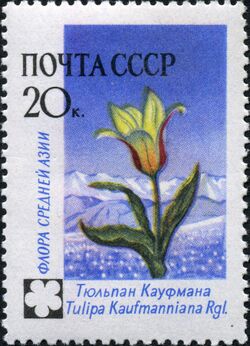Biology:Tulipa kaufmanniana
| Tulipa kaufmanniana | |
|---|---|

| |
| Tulipa kaufmanniana 'Giuseppe Verdi' | |
| Scientific classification | |
| Kingdom: | Plantae |
| Clade: | Tracheophytes |
| Clade: | Angiosperms |
| Clade: | Monocots |
| Order: | Liliales |
| Family: | Liliaceae |
| Subfamily: | Lilioideae |
| Tribe: | Lilieae |
| Genus: | Tulipa |
| Species: | T. kaufmanniana
|
| Binomial name | |
| Tulipa kaufmanniana Regel[1]
| |
| Synonyms[2] | |
|
Tulipa berkariensis Rukšans | |
Tulipa kaufmanniana, the water lily tulip, is a species of tulip native to Central Asia.[2]
Description
The tulip has a short stem, 20–25 cm (8–10 in) long,[3] making it a dwarf tulip.[4]
It has lance shaped leaves which may be plain green,[3] or blue-green.[5] They also often have purple markings on their leaves.[6]
It is one of the earliest tulips to bloom,[3][4] between February and April.[5]
The funnel-shaped flower,[3] has six pointy petals that open out like a star similar to water lilies, hence the common name.[5] They open very wide on sunny days.[4] They usually have outermost petals with a different colour than interior petals.[6] The long upright petals often have a flushed orange-red,[5] red or purple flush on the back of the petal.[3] Inside the petal, there may be a butter-yellow,[5] or yellow blotch and sometimes with further red markings.[3] There are also red, orange, pink and clear yellow forms too.[5]
After it has flowered it will form seeds.[7]
Taxonomy
It is commonly known as the 'Water-lily Tulip'.[8] because the petals of the flower open out like a star or waterlily.[5][3][4]
The Latin specific epithet kaufmanniana refers to Konstantin von Kaufman (1818-1882) who was the first Governor-General of Russian Turkestan where the tulip was found.
It was first found in Turkestan,[9][10] and then published and described by Eduard August von Regel in his botanical magazine 'Gartenflora' Vol.26 on page 194 in 1877.[11][9][12] It was also published by Regel in Act. Hort. Petrop. Vol.5. on page 265 in 1877.[9]
Distribution and habitat
Tulipa kaufmanniana is native to temperate areas of Central Asia.[12] It has naturalised between southern Europe, North Africa, and Asia from Anatolia and Iran in the west to northeast of China.[7]
Range

It is found in Kyrgyzstan,[12] Tajikistan and in Kazakhstan.[5]
As well as found on the mountains of Tien-Shan,[5][13] the Pamir and Hindu Kush mountains.[7]
Habitat
T. kaufmanniana grows in the wild on stony hillsides,[5] and steppes.[7]
Cultivation
They are suitable to be grown in the rock garden, bed and borders.[4] It is suitable for growing in USDA Growing Zones: 3 to 8, in full sun and soils with medium moisture retention or well-drained soils.[10]
Seed germination of the tulip has been studied, and it was concluded that stratification for 7 weeks was more effective treatment on studied traits than 5 weeks. Moreover, cold stratification was a better treatment on breaking seed dormancy of the seeds.[7]
Cultivars
They and their hybrids are placed in Group 12, the Kaufmanniana Group, by the Royal Horticultural Society.[6] Their leaves often have dashes and streaks of purple, which show the influence of Tulipa greigii in the breeding programmes.[3]
It was given the First Class Certification by the Royal Horticultural Society in 1897.[14]
The cultivars 'Ancilla', 'Early Harvest', 'Showwinner' (deep red[5]) and 'Stresa' have gained the Royal Horticultural Society's Award of Garden Merit.[15][16][17][18] Two other Group 12 cultivars are listed by the RHS as gaining the Award of Garden Merit, 'Alfred Cortot' and 'Glück'.[19][20]
Other known hybrids include 'Heart's Delight', a soft pink with an orange-yellow eye, the clear yellow 'Chopin' and white 'Concerto'.[5] In America, common cultivars include; 'Ancilla' soft pink, red and white flowers, 'Johann Strauss' rosy red and sulfur yellow blooms and 'Stresa' golden yellow with carmine red flowers.[4]
Culture
In the 1960s, a postage stamp in CCCP (Russia), was issued with an image of the tulip.[21] Then in 1993, a postage stamp in Uzbekistan, within the Flowers series was issued with an image of the tulip.[22]
References
- ↑ Gartenflora 26: 194 (1877)
- ↑ 2.0 2.1 "Tulipa kaufmanniana Regel". Board of Trustees of the Royal Botanic Gardens, Kew. 2017. http://powo.science.kew.org/taxon/urn:lsid:ipni.org:names:542962-1.
- ↑ 3.0 3.1 3.2 3.3 3.4 3.5 3.6 3.7 Richard Wilford The Plant Lover's Guide to Tulips (2015), p. 62, at Google Books
- ↑ 4.0 4.1 4.2 4.3 4.4 4.5 The National Gardening Association; Bob Beckstrom, Karan Davis Cutler, Kathleen Fisher, Phillip Giroux, Judy Glattstein, Michael MacCaskey, Bill Marken, Charlie Nardozzi, Sally Roth, Marcia Tatroe, Lance Walheim and Ann Whitman Gardening All-in-One For Dummies (2003), p. 552, at Google Books
- ↑ 5.00 5.01 5.02 5.03 5.04 5.05 5.06 5.07 5.08 5.09 5.10 5.11 Lyte, Charles (27 Mar 2004). "How to grow: Water-lily tulips". The Telegraph. http://www.telegraph.co.uk/gardening/howtogrow/3318759/How-to-grow-Water-lily-tulips.html. Retrieved 19 September 2017.
- ↑ 6.0 6.1 6.2 "Tulipa kaufmanniana (12)". The Royal Horticultural Society. https://www.rhs.org.uk/Plants/94833/i-Tulipa-kaufmanniana-i-(12)/Details. Retrieved 30 August 2020.
- ↑ 7.0 7.1 7.2 7.3 7.4 Rouhi, H. R.; Shakarami, K.; Tavakkol Afshari, R. (2010). "Seed treatments to overcome dormancy of waterlily tulip (Tulipa kaufmanniana Regel.)". Australian Journal of Crop Science 4 (9): 718–721. http://www.cropj.com/tavakol_4_9_2010_718_721.pdf. Retrieved 19 September 2017.
- ↑ "Tulipa kaufmanniana — Classifications". http://eol.org/pages/1082869/names?all=1. Retrieved 19 September 2017.
- ↑ 9.0 9.1 9.2 "Liliaceae Tulipa kaufmanniana Regel". ipni.org. http://www.ipni.org/ipni/idPlantNameSearch.do?id=542962-1. Retrieved 19 September 2017.
- ↑ 10.0 10.1 McIntosh, Jamie (21 March 2020). "14 Tulip Varieties to Plant for Spring Blooms" (in en). https://www.thespruce.com/tulip-types-for-spring-garden-1315804. Retrieved 17 April 2020.
- ↑ "Tulipa kaufmanniana Regel is an accepted name". theplantlist.org (The Plant List). 23 March 2012. http://www.theplantlist.org/tpl1.1/record/kew-289545. Retrieved 19 September 2017.
- ↑ 12.0 12.1 12.2 "Taxon: Tulipa kaufmanniana Regel". https://gringlobal.iita.org/gringlobal/taxonomydetail.aspx?id=40740.
- ↑ By Michael Fergus and Janar Jandosova Kazakhstan: Coming of Age, p. 59, at Google Books
- ↑ "Wild Kaufmanniana". http://www.paghat.com/tulipakauf.html. Retrieved 19 September 2017.
- ↑ "Tulipa 'Ancilla' (12)". The Royal Horticultural Society. https://www.rhs.org.uk/Plants/76910/Tulipa-Ancilla-(12)/Details. Retrieved 1 September 2020.
- ↑ "Tulipa 'Early Harvest' (12)". The Royal Horticultural Society. https://www.rhs.org.uk/Plants/56815/Tulipa-Early-Harvest-(12)/Details. Retrieved 1 September 2020.
- ↑ "Tulipa 'Showwinner' (12)". The Royal Horticultural Society. https://www.rhs.org.uk/Plants/66436/i-Tulipa-i-Showwinner-(12)/Details. Retrieved 30 August 2020.
- ↑ "Tulipa 'Stresa' (12)". The Royal Horticultural Society. https://www.rhs.org.uk/Plants/98684/i-Tulipa-i-Stresa-(12)/Details. Retrieved 30 August 2020.
- ↑ "Tulipa 'Alfred Cortot' (12)". The Royal Horticultural Society. https://www.rhs.org.uk/Plants/74292/Tulipa-Alfred-Cortot-(12)/Details. Retrieved 1 September 2020.
- ↑ "Tulipa 'Glück' (12)". The Royal Horticultural Society. https://www.rhs.org.uk/Plants/93729/Tulipa-Gluck-(12)/Details. Retrieved 1 September 2020.
- ↑ "Welcome to Stamps Collector Catalogue, Water-lily tulip". http://stamps.livingat.org/Keywords.aspx?nav=Search&subNav=keywords&searchStr=Tulipa+kaufmanniana+rgl.
- ↑ "Stamp › Tulipa kaufmanniana". colnect.com. https://colnect.com/en/stamps/stamp/217758-Tulipa_kaufmanniana-Flowers-Uzbekistan.
Other sources
- Aldén, B., S. Ryman, & M. Hjertson. 2012. Svensk Kulturväxtdatabas, SKUD (Swedish Cultivated and Utility Plants Database; online resource) URL: www.skud.info
- Christenhusz, J. M.. et al. 2013. Tiptoe through the tulips - cultural history, molecular phylogenetics and classification of Tulipa (Liliaceae). Bot. J. Linn. Soc. 172:280-328.
- Encke, F. et al. 1993. Zander: Handwörterbuch der Pflanzennamen, 14. Auflage
- Groth, D. 2005. pers. comm. Note: re. Brazilian common names
- Huxley, A., ed. 1992. The new Royal Horticultural Society dictionary of gardening
- Komarov, V. L. et al., eds. 1934–1964. Flora SSSR.
- Liberty Hyde Bailey Hortorium. 1976. Hortus third.
- Marasek-Ciolakowska, A. et al. 2012. Breeding and cytogenetics in the genus Tulipa. Floriculture, Ornamental and plant biotechnology: Advances and topical issues. Volumes I-V. Global Science Books., London. 6(Special issue):90-97.
- Mathew, B. F. 1996. pers. comm. Note: re. common names
- Raamsdonk, L. W. D. van & T. de Vries. 1995. Species relationships and taxonomy in Tulipa subg. Tulipa (Liliaceae). Pl. Syst. Evol. 195:41.
- Walters, S. M. et al., eds. 1986–2000. European garden flora.
Wikidata ☰ Q2265529 entry
 |


